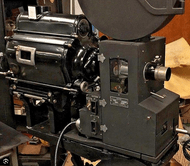Safety and Ventilation in the Carbon Arc Projection Era
Posted by Julio Urbay on 20th Jun 2025
In the golden age of film projection, carbon arc lamps were the industry standard for illuminating the silver screen. But behind the scenes, these powerful light sources posed serious risks to the projectionists who operated them. The carbon arc era was not just a time of cinematic innovation—it was also a period marked by intense heat, toxic fumes, and the constant need for vigilance.
The Hazards of Carbon Arc Lamps
Carbon arc lamps worked by creating an electric arc between two carbon rods, generating a brilliant white light. While visually stunning, this process came with a host of dangers. The arc produced extreme heat, ultraviolet radiation, and a cocktail of hazardous byproducts including carbon monoxide and fine carbon dust. In poorly ventilated booths, these emissions could accumulate quickly, creating a toxic environment for projectionists.
The rods themselves burned down rapidly and had to be manually adjusted or replaced during operation. This meant projectionists were often working in close proximity to open arcs, risking burns, eye damage, and exposure to harmful gases. Protective gear was minimal in the early days, and many operators suffered long-term health effects from repeated exposure.
Ventilation: A Matter of Survival
To combat these dangers, ventilation became a critical component of projection booth design. Early booths were often equipped with heavy-duty exhaust fans and ductwork designed to pull heat and fumes away from the operator and out of the building. Some systems included chimney-style vents directly above the lamphouse, while others relied on cross-ventilation and intake fans to maintain airflow.
In many cases, local fire codes and building regulations mandated specific ventilation standards for projection rooms. These included requirements for fireproof construction, sealed booth doors, and dedicated air circulation systems. The goal was not only to protect the projectionist but also to reduce the risk of fire—especially when nitrate film was still in circulation.
The Projectionist’s Role in Safety
Operating a carbon arc projector was as much about technical skill as it was about safety awareness. Projectionists had to monitor lamp current, rod alignment, and airflow constantly. They kept fire extinguishers close at hand and were trained to respond quickly to overheating or electrical faults. In some theaters, projectionists even wore asbestos gloves when handling hot components.
Despite the risks, many projectionists took pride in their work and developed a deep respect for the equipment they operated. The booth was their domain, and safety was part of the craft.
Legacy and Lessons
Today, carbon arc lamps have largely disappeared from commercial use, replaced by safer and more efficient technologies. But the lessons learned during that era—about workplace safety, ventilation, and the importance of skilled operators—continue to influence projection booth design and cinema operations.
The carbon arc era was a time of brilliance and danger, where the glow of the screen was matched by the heat of the arc and the vigilance of those behind the glass.

